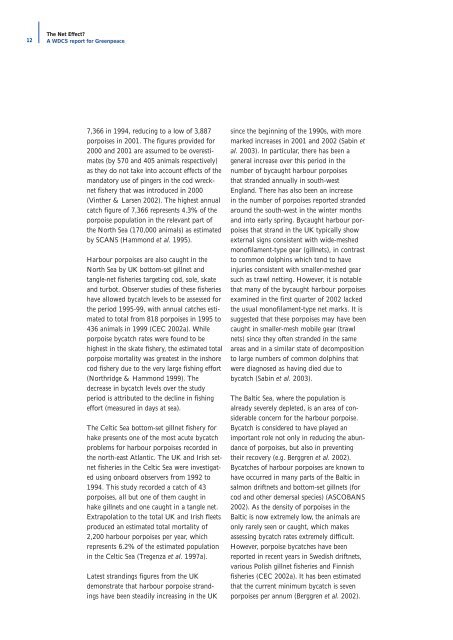The Net Effect? - Whale and Dolphin Conservation Society
The Net Effect? - Whale and Dolphin Conservation Society
The Net Effect? - Whale and Dolphin Conservation Society
You also want an ePaper? Increase the reach of your titles
YUMPU automatically turns print PDFs into web optimized ePapers that Google loves.
12<br />
<strong>The</strong> <strong>Net</strong> <strong>Effect</strong>?<br />
A WDCS report for Greenpeace<br />
7,366 in 1994, reducing to a low of 3,887<br />
porpoises in 2001. <strong>The</strong> figures provided for<br />
2000 <strong>and</strong> 2001 are assumed to be overestimates<br />
(by 570 <strong>and</strong> 405 animals respectively)<br />
as they do not take into account effects of the<br />
m<strong>and</strong>atory use of pingers in the cod wrecknet<br />
fishery that was introduced in 2000<br />
(Vinther & Larsen 2002). <strong>The</strong> highest annual<br />
catch figure of 7,366 represents 4.3% of the<br />
porpoise population in the relevant part of<br />
the North Sea (170,000 animals) as estimated<br />
by SCANS (Hammond et al. 1995).<br />
Harbour porpoises are also caught in the<br />
North Sea by UK bottom-set gillnet <strong>and</strong><br />
tangle-net fisheries targeting cod, sole, skate<br />
<strong>and</strong> turbot. Observer studies of these fisheries<br />
have allowed bycatch levels to be assessed for<br />
the period 1995-99, with annual catches estimated<br />
to total from 818 porpoises in 1995 to<br />
436 animals in 1999 (CEC 2002a). While<br />
porpoise bycatch rates were found to be<br />
highest in the skate fishery, the estimated total<br />
porpoise mortality was greatest in the inshore<br />
cod fishery due to the very large fishing effort<br />
(Northridge & Hammond 1999). <strong>The</strong><br />
decrease in bycatch levels over the study<br />
period is attributed to the decline in fishing<br />
effort (measured in days at sea).<br />
<strong>The</strong> Celtic Sea bottom-set gillnet fishery for<br />
hake presents one of the most acute bycatch<br />
problems for harbour porpoises recorded in<br />
the north-east Atlantic. <strong>The</strong> UK <strong>and</strong> Irish setnet<br />
fisheries in the Celtic Sea were investigated<br />
using onboard observers from 1992 to<br />
1994. This study recorded a catch of 43<br />
porpoises, all but one of them caught in<br />
hake gillnets <strong>and</strong> one caught in a tangle net.<br />
Extrapolation to the total UK <strong>and</strong> Irish fleets<br />
produced an estimated total mortality of<br />
2,200 harbour porpoises per year, which<br />
represents 6.2% of the estimated population<br />
in the Celtic Sea (Tregenza et al. 1997a).<br />
Latest str<strong>and</strong>ings figures from the UK<br />
demonstrate that harbour porpoise str<strong>and</strong>ings<br />
have been steadily increasing in the UK<br />
since the beginning of the 1990s, with more<br />
marked increases in 2001 <strong>and</strong> 2002 (Sabin et<br />
al. 2003). In particular, there has been a<br />
general increase over this period in the<br />
number of bycaught harbour porpoises<br />
that str<strong>and</strong>ed annually in south-west<br />
Engl<strong>and</strong>. <strong>The</strong>re has also been an increase<br />
in the number of porpoises reported str<strong>and</strong>ed<br />
around the south-west in the winter months<br />
<strong>and</strong> into early spring. Bycaught harbour porpoises<br />
that str<strong>and</strong> in the UK typically show<br />
external signs consistent with wide-meshed<br />
monofilament-type gear (gillnets), in contrast<br />
to common dolphins which tend to have<br />
injuries consistent with smaller-meshed gear<br />
such as trawl netting. However, it is notable<br />
that many of the bycaught harbour porpoises<br />
examined in the first quarter of 2002 lacked<br />
the usual monofilament-type net marks. It is<br />
suggested that these porpoises may have been<br />
caught in smaller-mesh mobile gear (trawl<br />
nets) since they often str<strong>and</strong>ed in the same<br />
areas <strong>and</strong> in a similar state of decomposition<br />
to large numbers of common dolphins that<br />
were diagnosed as having died due to<br />
bycatch (Sabin et al. 2003).<br />
<strong>The</strong> Baltic Sea, where the population is<br />
already severely depleted, is an area of considerable<br />
concern for the harbour porpoise.<br />
Bycatch is considered to have played an<br />
important role not only in reducing the abundance<br />
of porpoises, but also in preventing<br />
their recovery (e.g. Berggren et al. 2002).<br />
Bycatches of harbour porpoises are known to<br />
have occurred in many parts of the Baltic in<br />
salmon driftnets <strong>and</strong> bottom-set gillnets (for<br />
cod <strong>and</strong> other demersal species) (ASCOBANS<br />
2002). As the density of porpoises in the<br />
Baltic is now extremely low, the animals are<br />
only rarely seen or caught, which makes<br />
assessing bycatch rates extremely difficult.<br />
However, porpoise bycatches have been<br />
reported in recent years in Swedish driftnets,<br />
various Polish gillnet fisheries <strong>and</strong> Finnish<br />
fisheries (CEC 2002a). It has been estimated<br />
that the current minimum bycatch is seven<br />
porpoises per annum (Berggren et al. 2002).

















